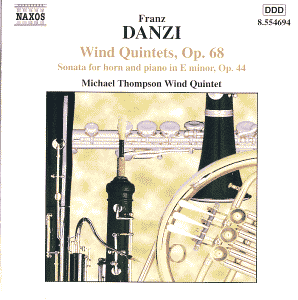Franz DANZI (1763-1826)
Wind Quintet in A major, Op. 68, No. 1
Wind Quintet in F major, Op. 68, No. 2
Wind Quintet in D minor, Op. 68, No. 3
Sonata for horn and piano in E minor, Op. 44*
 Michael Thompson Wind
Quintet
Michael Thompson Wind
Quintet
Michael Thompson (horn) / Philip Fowke (piano)*
rec 1995, St Paul's Church, Rustall, Kent; Broomhill Theatre, Tunbridge Wells,
Kent*
 NAXOS 8.554694
78'54"
NAXOS 8.554694
78'54"
Crotchet
AmazonUK
AmazonUS
Amazon
recommendations

With this generously filled disc, Naxos complete their survey of Danzi's
three sets of Wind Quintets and give us Danzi's second Horn Sonata
as a substantial bonus.
Danzi's first set of three Wind Quintets (available on Naxos 8.553076) was
written following the success of Reicha's ground-breaking works for this
ensemble of flute, oboe, clarinet, horn and bassoon. Encouraged by his own
success, Danzi published two further sets of three in the early 1820s. This
time, however, Danzi dispensed with his dedication to Reicha.
The first Quintet in A major (not A minor, as the accompanying booklet has
it) opens with a delightful movement. This demonstrates Danzi's skill at
writing music which is totally suited to the instruments for which he is
writing. A short Larghetto leads to a Haydnesque Minuetto.
The final movement is a triple-time Polacca rondo with florid arpeggios
for the horn. Did Elgar know these quintets when writing his own "Shed Music"
fifty years later?
The second Quintet is in F major (and this time Naxos have the modality correct).
A brisk and substantial Allegro is followed by an Andante slow
movement which is a set of variations. The minuet has some quirky writing
for the flute and leads to an Allegretto finale which gives the horn
player a chance to shine.
The final Quintet, in D minor, opens with a slow introduction which allows
all the instruments to show off their ability to strike a plaintive, sustained
note. The ensuing Allegretto is in complete contrast, in D major,
and features a syncopated melody of considerable charm. The slow movement
again allows for some beautiful sustained playing from all instruments. The
syncopated, minor-key Minuetto is followed by a hushed opening to
the final movement. Danzi allows himself a few more surprises during the
course of this Allegro assai ending to the entire set.
The Michael Thompson Wind Quintet play these works with verve, sensitivity
and considerable charm. Michael Thompson takes a lead role in the Op 44 sonata,
dating from 1813. This was only twelve years after Beethoven had written
the first ever horn sonata. The somewhat conventional piano part, bristling
with arpeggios and scales, contrasts well with the more lyrical horn part.
Thompson plays this on a modern valved horn which makes for accuracy, though
the more subtle tone colouring of the natural horn would have better served
the slow movement. Philip Fowke manages to obtain some suitably period sounds
from his modern piano.
Naxos's recording, made at two different locations in Kent, is excellent.
Chris Goddard

